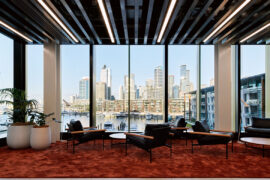Jeames Hanley discusses four ways in which design practices can make the most of AI and automation to boost their design value in 2025.

Jeames Hanley, photograph by Jes Lindsay.
February 28th, 2025
The integration of AI technologies in architecture and design practices is moving forward at a rapid pace, shaping the way we work and the future of the built environment. In my role leading the digital transformation strategy at Buchan, I am implementing AI tools across all aspects of our global business. It’s exciting to see how this is driving innovation across everything from design and delivery to day-to-day operations.
Regardless of the size of your practice, AI and automation can boost efficiency and be a powerful partner to human creativity and expertise. Is it a threat to jobs? Far from it, for those ready to jump in, learn how the technology works and master its use. AI and automation can help you deliver higher quality work, whilst freeing up time for the exploration and problem solving that is the real value designers bring to the table. Individuals and practices who upskill will reap the rewards.
Here are four ways to harness technology to increase your value this year, along with some red flags and how to avoid them.
1. Take visualisation to new levels
The most visible use of AI in architecture and design is image generation, using tools such as Midjourney and Stable Diffusion. These tools create immediate and highly realistic renders, boosting creative exploration and enabling quick ideation and iteration. Clients value compelling visuals that make concepts easy to understand, test and refine within short timeframes.
2. Supercharge information gathering and compliance
Web-based AI tools such as Chat GPT and Microsoft Copilot can be trained to assist with many common tasks, increasing efficiency and improving the quality of your outputs. ‘Training’ an AI tool means telling it where to look, whether at data on the web or at company-specific data stored securely on your internal systems. Use AI tools to quickly compile research, generate text for reports and submissions, or to find compliance and regulatory specifications.
An example is a Chat GPT assistant I created (freely available to anyone via this link), which is trained on the National Construction Code (NCC). Ask it the question, ‘What are the minimum dimensions for an accessible toilet in a public building?’ It instantly gives you the relevant information with links to the source. Saving time on these tasks frees up time for the creative work that AI can’t do – a win for you and for your clients.
3. Create accurate documentation fast and reduce risk
Automation has long been applied to generate geometry, create drawings and input or place annotative elements. AI tools are now leveraging automation and delivering real benefits to this part of the architectural process. Perform building code analysis and compliance checks and automate defects reporting and ordering. AI tools can do all of this, increasing the quality of your documentation whilst reducing the time needed to create it. AI tools can also reduce the burden of risk. How? By feeding data directly into BIM models, increasing the accuracy of that data so that responsibility can be more equitably shared across consultants and contractors.
4. Leverage your knowledge bank
Eureka! Use AI tools to leverage the years of experience and expertise embedded in your practice. For studios like Buchan with decades of completed projects around the globe, this is highly beneficial. Off-the-shelf AI tools can be locally downloaded and trained on your project database, allowing anyone in the business to mine information from your archives. Designing a new sports facility? Look for similar typologies or site conditions. Working with a repeat client? Tailor your design to the client’s known preferences and requirements and generate images using only your practice’s previous projects as the reference. This delivers real value to existing clients and is a selling point for prospective clients looking to build strong relationships.
Red flags, tips and tricks
Remember, AI and automation are only ever tools to support human creativity and expertise. Stay in control and be alert to possible pitfalls.
And finally, be conscious that AI is an energy- and resource-intensive tool. High-level data processing and image generation uses huge amounts of power and water. Aside from environmental issues, this also has ESG implications for your client’s projects. I anticipate tools that can quantify AI’s environmental impact will soon become available. All technology needs to be used responsibly – don’t use AI when something else can do the job, like a simple calculator!

Jeames Hanley is a digital strategist and design technology specialist with more than 15 years of experience in applying technology across the built environment. He leads the digital transformation strategy at Buchan, where he is implementing workflows centred around automation, algorithmic design, machine learning, AI and digital twin technologies, as well as across business operations.
Buchan
buchan.au
More on technology and AI in this podcast with Paul Milinski
INDESIGN is on instagram
Follow @indesignlive
A searchable and comprehensive guide for specifying leading products and their suppliers
Keep up to date with the latest and greatest from our industry BFF's!

London-based design duo Raw Edges have joined forces with Established & Sons and Tongue & Groove to introduce Wall to Wall – a hand-stained, “living collection” that transforms parquet flooring into a canvas of colour, pattern, and possibility.

Welcomed to the Australian design scene in 2024, Kokuyo is set to redefine collaboration, bringing its unique blend of colour and function to individuals and corporations, designed to be used Any Way!

For Aidan Mawhinney, the secret ingredient to Living Edge’s success “comes down to people, product and place.” As the brand celebrates a significant 25-year milestone, it’s that commitment to authentic, sustainable design – and the people behind it all – that continues to anchor its legacy.

Brett Ward, General Manager of Marketing at Brickworks, tells us how modern approaches to sustainability are intersecting with the long history of the brick.

Seven years in the making, the new Surry Hills Village is here with doors open and crowds gathering.
The internet never sleeps! Here's the stuff you might have missed

Warren and Mahoney’s design for Beca’s Auckland headquarters turns the mechanics of engineering into poetry, rethinking how workplace design can reveal its own systems.

Cieran Murphy has been awarded The Photographer – Commercial at the INDE.Awards 2025. His work on Lune Rosebery captures the immersive design and storytelling of the space, highlighting the interplay of form, material and atmosphere in this contemporary culinary destination.